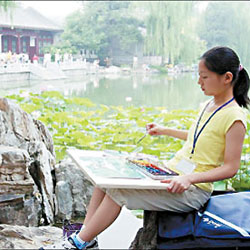
"Campus tourism" has become something of a trend in recent years at Beijing's oldest seats of learning. The capital's most famous universities with long histories and traditions, like Peking University, have become popular destinations for visitors because of their beautiful and historic locations. Now thousands of travelers make a pilgrimage every day to these universities.
In fact, as the premier university in the Chinese capital, Peking University had to close its gates to visitors two years ago for security reasons because there had been simply "too many" visitors.
Among these visitors were parents of prospective students wanting to get a sense of the atmosphere of the school before deciding to enrol their kids.
But later the university reopened its gates to allow all visitors, after a debate took place that year.
Since the first week of September is the time when students return to campus, a trip to a university at this time of year will find more of interest than just the pleasant views of architecture and the university's cultural relics. You can see new students taking in their baggage and wondering around the campus with curiosity. Most of them are accompanied by parents or other family members.
Traffic around different colleges and universities becomes busy. The roads around the campuses would become crowded parked with lots of cars. You will find they are from many different regions of China, judging the cars' license plates.
Peking University has long been the place of dreams for both Chinese students and their parents. So when students are admitted to the university, parents don't want to miss the chance of a trip to Peking University together with their children.
Peking University is a comprehensive and national key university in China. The campus, also known as "Yan Yuan" is situated in the northeast of the Haidian District in the western suburbs of Beijing.
It stands near the Yuanmingyuan (Old Summer Palace) and the Summer Palace.
It was opened in December 1898. The then named Metropolitan University was not only the most prestigious institution of higher learning but also the highest administrative organization of education in China.
Now the university covers 236 hectares, excluding the area of Beijing Medical University and one in north suburban Changping District, which are affiliated to the university.
Usually one day is enough to finish a tour of the campus. But if you take a bike, half day is enough and you can use the remaining time to go around the nearby Tsinghua University.
We suggest that you'd be better off walking around so that you don't miss the more interesting details. However, a bike may be preferred by some to tour around such a huge campus.
There is a bike rental store outside the west gate of Tsinghua University. The rental fee is one yuan (12 cents) per hour, plus a 100 yuan (US$12) returnable deposit.
The west gate of Peking University is the main gate of the campus.
The main attractions for visitors include the Alumni Bridge, the Archaeology and Art museum, the Honghu building, Jingchun Garden, the campus gymnasium, Weiming Lake, the university library, the great lecture hall, food and business streets and the overall traditional architecture of the campus. Among these sites, only the Archaeology and Art Museum requires a ticket, costing five yuan (61 US cents).
The library of Peking University is not open to outside visitors. It is only available for teachers and students in the university.
To get to the university, take buses 331, 740, 810, 834 or 983. Almost all taxi drivers know the location of "Beida" or Beijing Daxue (Peking University).
Surrounding sites worth visiting: Summer Palace, Yuanmingyuan (Old Summer Palace) and Tsinghua University.
(China Daily September 2, 2005)
|

